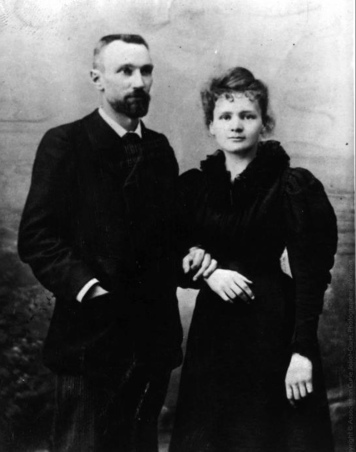This blog post is a little different to my pharmacological posts, because instead I want to recount a little history of science. It’s a story of tragedy, scandal, blackmail and a delicious happy ending.
 Yesterday, 26th July, marked the anniversary when, in 1895, Marie Sklodowska married Pierre Curie (their wedding photograph is shown on the left). Marie Curie, of course, became one of the most famous names in science. She was the first women to win a Nobel prize and the first person to receive two Nobel prizes, one in physics and one in chemistry.
Yesterday, 26th July, marked the anniversary when, in 1895, Marie Sklodowska married Pierre Curie (their wedding photograph is shown on the left). Marie Curie, of course, became one of the most famous names in science. She was the first women to win a Nobel prize and the first person to receive two Nobel prizes, one in physics and one in chemistry.
Born Maria Salomea Skłodowska in Warsaw in 1867, her family called her by her nickname, Manya. Warsaw was part of the Kingdom of Poland in the Russian Empire, and Czar Alexander II was not too keen on educating the masses. Manya became a member of a group known as the Floating University, where gatherings took place in secret, because discovery would have meant imprisonment. In 1891, with the financial help of her sister, Bronisława, Manya moved to Paris to become a student at the Sorbonne, one of the few institutions to admit women. In Paris, she adopted the more French name of Marie. Before she embarked on her famous work on radioactivity, Marie researched the magnetic properties of steel and it was during this research she met Pierre Curie, who later became her husband.
Marie and Pierre were happily married for eleven years and had two daughters, Irène and Ève* (more on Irène shortly). Then, on April 19, 1906, Pierre was run over by a horse-drawn carriage and killed instantly. Pierre’s death devastated Marie, but as time heals, in around 1910, she fell in love with a physicist and former student, Paul Langevin. The problem was Langevin was a married man. They kept the affair secret for a year, but his estranged wife, Jeanne, hired a private detective to steal love letters from the couple, which she then made public.
Today, perhaps, adultery is almost a qualification for high office, but in the early 1900s, Marie Curie and Paul Langevin’s affair was pure scandal. This went as far that when Marie was awarded her second Nobel prize in 1911, there were moves to keep her out of the ceremony. The King of Sweden, Gustav V, intervened and insisted she should attend. At the banquet that followed the ceremony, Gustav sat with Marie, and they seemed to get on well. In the years that followed, Gustav was also plunged into scandal over an alleged homosexual affair with a married man, Kurt Haijby. It didn’t end well for Haijby because he was jailed in 1952 for attempting to blackmail the King.
To round this story off, we end up with Marie Curie’s granddaughter, Helene Joliot. She was the daughter of Irène Curie, who had become Irène Joliot-Curie, when she married the chemical engineer Frédéric Joliot. Like her mother, Irène Joliot-Curie also won a Nobel prize for her work on radioactivity. Helene Joliot, in her turn, married, but by one of those great coincidences of history, to Michel Langevin, the grandson of Paul Langevin, with whom Marie had had the affair years before. Marie Curie and Paul Langevin never ended up together, but at least their grandchildren did.
(*- Ève Curie wrote “Madame Curie – A biography” The book is available in English, translated by Vincent Sheean).
If you’re interested in the history of radiotracers then I will unashamidly point you towards: Lappin, G. ‘A Historical Perspective on Radioisotopic Tracers in Metabolism and Biochemistry’. Bioanalysis 7, no. 5 (March 2015): 531–40.
LikeLike
Thanks Graham – really interesting read
LikeLike